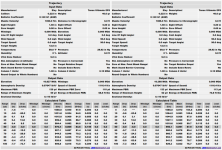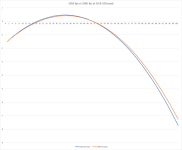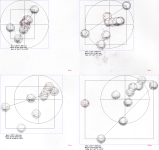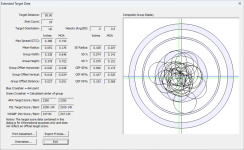Missed ya Shorty. Do your results suggest a distance at which PC is maxed out? (if that is not too naive of a question) It seems intuitive that at some point there will be a limit to the amount and rate of barrel rise and therefore PC. Thanks for the amazing contribution.
Well, if we consider what's going on it definitely stands to reason that at some point you can no longer get things to move the way they need to move in order to provide the most help, yeah. If we work out the amount of PC required for each distance it should become apparent whether or not it is something that will remain feasible as you go further and further out. 50-yard benchrest competitions have shown for decades now that 50 yards is definitely in the feasible range. If we take the 1050/1085 fps example and one of the things gleaned from Geoffrey Kolbe's experimentation we can figure out the amount of PC needed for 50 yards rather easily. He figured there seemed to be a roughly 375 fps range accounting for a difference in muzzle exit timing of 1 millisecond. So for every 1 fps increase in muzzle velocity there should be around 1/375th of a millisecond decrease in muzzle exit delay. So for 1050 and 1085 fps we are looking at a difference of 35 fps, and a launch angle difference of 0.459 MOA. (The fairly inconsistent behaviour of 22 LR ammo makes it hard to say exactly 375, too. His data looked pretty noisy, and that's because of how consistent the ammo actually is, or isn't. This is also why you probably need to retweak after changing lot numbers. Exit timing is fighting muzzle swing, and exit timing will/should change between lot numbers. It might be a minimal tweak, but probably *a* tweak.)
0.459 / 35 = roughly 0.0131143 MOA per 1 fps
roughly 0.013114 * 375 = roughly 4.92 MOA per millisecond of upward swing to get good PC for 50 yards. Geoffrey found roughly 6 MOA/ms for 50 metres.
For 100 yards we need these launch angles:
1050 fps 18.198 MOA
1085 fps 17.304 MOA
0.894 MOA difference
0.894/35 = roughly 0.025543
*375 = roughly 9.58 MOA per millisecond of upward swing to get good PC for 100 yards.
That's quite the difference.
for 200 yards
1050 fps 37.525 MOA
1085 fps 35.785 MOA
1.74 MOA difference
1.74/35 = roughly 0.0497143 MOA per 1 fps
*375 = roughly 18.64 MOA per millisecond
Typical benchrest barrel length and contour with typical tuners can obviously get you to 4.92 MOA/ms of upward swing. Moving to 100 yards is going to require speeding that up quite a bit. And quite a bit again for 200 yards. The limiting factor is going to be what the bare barrel speed actually is, since all we can do with a tuner is slow things down. You have to change the barrel contour, and/or probably length, to speed things up. Slapping a tuner on only slows things down, and you need to get the weight roughly correct to slow it down into roughly the right range. And then the actual tuning adjustment gets it fine-tuned. This is precisely why benchrest barrels tend to be pretty much the same length and contour for a given competition, because you all need to be able to get the barrel moving in the same way.
So, how fast is a bare barrel? That's obviously going to depend on length and contour. And I don't really have an answer for this one, as I've never tried to determine how fast any of my bare barrels is moving. (Well, actually, I do have a general idea of how fast my two-flats barrel is moving, but that's another story, and an unusual one.) If I had to guess, I would say this is probably something you could determine with a chronograph and OnTarget software. You could compare the behaviour of actual shots with the expected outcome of ballistically perfect shots for those speeds and figure out how far off the mark things are, providing things are behaving in a relatively sane way, which may not be a given, hehe. It would kind of depend on whether or not you're seeing shots leave around the same time as the direction reversals take place. If you luck out and you aren't seeing reversals then it should be a straight forward task. If you are seeing reversals then you could probably work around it by adding a really small amount of weight to the muzzle. And you should be able to calculate the muzzle swing speed from that. Then you could figure out whether or not it is a waste of time trying to tune for 100 or 200 yards or if it is something you could do. If I had to guess, given how much weight is in a typical tuner, it might be possible that it is moving more than fast enough when bare to make tuning at usable distances feasible. Testing it would obviously tell us how good of a guess that is, hehe. The further out you go, the faster it needs to be. So there would be some limit. I don't know if you'd run into the ammo's usable distance first or not. Might be interesting to test this in order to try to figure that out, hehe.










































































